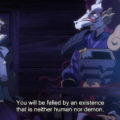Quarantine Control #153: Love Rises, Senpai

Now that COVID-19 is a thing of the past in the public eye (though hardly over per se, it’s important to note), the focus has now shifted to the origins of the virus. COVID was largely thought to have originated from an animal in China’s meat market, but at least two American agencies kind of sort of think it came from a Chinese lab. We’re still dealing with the virus, so too much importance is being paid to this. A certain crowd is convinced that it’s a Chinese bioweapon, though it’s a pitiful example considering most of the infected survive it. We’re not ready to shift the focus to the origins yet, but this was inevitable in a world where some people were angrier about the thought of lockdowns than the virus itself killing millions.
Geoffrey Barnes
I addressed one of my Anime Sins this week, if that’s a thing.
Trigun (1998)
Source: Crunchyroll
Episodes: 26

When I first started watching anime in the mid-to-late 1990s (from starting with Dragon Ball Z and Sailor Moon, and realizing there was more out there), I couldn’t stop hearing that Trigun was one of the best to start with, along with other popular gateway shows in the 26-episode sphere like Cowboy Bebop, Neon Genesis Evangelion, Outlaw Star, and the Vision of Escaflowne. I watched nearly all of those shows around the time they released after collecting them on DVD (though I didn’t fully see Outlaw Star until 2020). But I had, unforgivably, never watched Trigun. I put it off because, during the point at which I finally wanted to get around to it, I wanted to wait until a Blu-ray release or HD remaster. Now that it’s become clear that neither of those will happen, I figured I might as well watch it. I have to say that the praise was justified.
The aspect that’s forever intrigued me about Trigun is how it’s about a gunman, Vash the Stampede, in a western setting who believes in love and peace, but does his best not to kill anyone. The concept of this walking contradiction is reminiscent of, I’m sorry, Rurouni Kenshin; but it’s much harder for someone with a gun loaded with real bullets not to kill than a sword with a reverse blade, not to mention the differences between Trigun’s version of the Wild West and Japan’s Meiji Era.
Trigun is also reminiscent of that series through how it fluctuates between humor and seriousness, particularly with Bernardelli Insurance Society employees Meryl Strife and Milly Thompson, who follow Vash around to keep the damage that caused him to get a $$60 billion bounty on his head to a minimum. The premise sounds messy on the surface, but the series skillfully weaves between the two in a way that neither detracts from the other. There’s a reason why it was highly recommended, though it shifts towards seriousness in the series’ second half.
The aforementioned weaving of the moods is one among several of Trigun’s positive aspects. The series, in fact, emphasizes how it makes little sense for Vash to be a pacifist while carrying around a gun through a harsh world, to the chagrin of the character himself and some of those around him. The series goes to dark places in contrast to the mood suggested at its start, but not jarringly so. Trigun gets the important elements of the story right, including the world and character development, making for a series that remains a unique and stand-out example in anime form. Perhaps that applied to its manga form too.
But what I like most about the series is how old school its storytelling elements are compared to the TV shows, animated and live-action examples, made nowadays. Trigun’s 26 episodes allow for enough opportunity to include several that focus on the “main” story and plenty of episodic examples dedicated to character development and making its world feel lived in. It’s the kind of storytelling I miss seeing, now rarer thanks to both lower episode counts between seasons and cours (usually 10 or 13 outside now-rare examples for animated content and six to ten for live-action content) and the increasing amount of too-online people who jump at the chance to complain about content diverging from the main story as “filler.”
I won’t claim that all older anime was better at this; several examples, including the aforementioned Kenshin, have pitiful and contradictory anime-original filler episodes that included zero character development and building. But I appreciate Trigun for having an ample amount of both, and making the so-called “filler” content feel necessary to the overall story.
The action and comedy never cease to be entertaining. It’s a pity the animation can’t maintain that quality, even by late-1990s standards, though there are understandable reasons for that. Trigun wasn’t the best performer in Japan, with a western-style setting and characters that didn’t have as much appeal in its home country compared to western territories. This doesn’t harm the series too badly thanks to the directors and animators finding ways around their limitations. At least we received Trigun: Badlands Rumble, a beautifully-animated film.
Trigun is such an enjoyable series that I still can’t believe I didn’t watch it until now. It’s easy to see how it was hailed as a gateway series for so long, and it’s still perfectly enjoyable today. It’s a testament to how popular it became that the franchise persists, now with an anime reboot through Trigun Stampede. The jury’s still out on whether that will turn out well, but at least this one will be preserved.
Angela Moseley
Video games are an easy to go-to subject when I’m in between TV shows, movies, podcasts, or books. Heck, I’m going to get even lazier. I’m going to revisit a topic that I wrote about in September.
Monster Hunter Rise (2023)
Source: PS4
Episodes: 1 video game

In September 2022, I wrote about Monster Hunter Rise for Quarantine Control #126. I was not having a good time with the Switch version of the game, namely the controls, and how difficult it is to play multiplayer with friends. Every so often I had considered just starting over with the PC version, especially since I had recently upgraded my system with a better graphics card. Still, I figured I didn’t want to start the game over and still have the issue of having too few people to play with. Yes, playing with my friend (and friend of the blog) Super Nerdy Guy was a very good option, but I also wanted the option to play with my husband, and the entire crew from Monster Hunter World and Iceborne. Then in late 2022 it was announced that Rise would be ported to the PS5/PS4 and the Xbox Series X/Xbox One. I immediately jumped on the PS4 version of the game.
Moving to the PS4 version of Rise wasn’t a painless experience. For one thing, I had JUST purchased the Monster Hunter Rise: Sunbreak expansion on Switch. That means, I’d just dropped cash on a piece of DLC I will likely never play. Another big problem is the lack of cross-play and cross-save for Monster Hunter in general. Although I had only made about 15 to 20 hours of progress on the Switch version of the game, I had to kiss all of that goodbye and start anew on PlayStation. The souped up gear I’d received to make getting to Sunbreak easier was also gone, unless I waited until the spring for Sunbreak to launch on the PS4. I didn’t want to wait, especially since my friends had gotten the game. A final issue was that this game was digital everywhere, except for the vanilla version on the Switch. The trade-off was a lower price, but given how companies treat digital games, it would have been reassuring to have a physical copy on the PS4.
Steeling myself to restart this game from scratch, I spent awhile in the character creator until my human, palico, and palamute looked fairly similar to their Switch counterparts. I then began the grind in the game all over again. As of this writing, I’m close to where I was when I stopped playing on Switch, but the process has been a slog. All the difficulties of ranking up are still in the port. I complained about it on Mastodon and was given some helpful advice— doing Rampage quests is the fast way to get to high rank and to gain more levels. I’ve yet to implement doing more Rampage quests because the mechanic behind them is time-consuming. They’re basically mini-siege and tower-defense quests. As a hunter you have to set up units that will hold off the monsters and repel them from breaking down various gates and barriers. I don’t mind these types of quests in limited doses, but they really aren’t my style of gaming.
Thankfully, starting over on the PS4 does have some pluses. Gone are my complaints about how difficult it is to link up and play with friends. Getting together in a group is as easy and starting up an in-game session and inviting friends via PlayStation’s party chat feature. Or others can simply search for your open room and join. The same goes for voice chat. It’s all handled through PlayStation, so no complicated Discord or cellphone arrangements are needed. (It just goes to show you how far behind Nintendo is compared to Microsoft, Sony, and PC when it comes to multiplayer gaming.) My only complaint with multiplayer in Rise is that rooms are only limited to four players, versus the 16 in World/Iceborne. Sure, just like in previous Monster Hunter games, only a maximum of four players can go out on a hunt, but it was nice having up to 16 people in a lobby. Having only four players in a session just feels so limiting, especially if you have more than four friends on and playing the game at the same time.
The controls on the PlayStation feel great. They’re not exactly the same as Iceborne’s thanks to the inclusion of Wire Bugs and some changes in how combos work, but they feel similar enough. This alone has been worth slogging through the game again for. (Now, if I had put hundreds of hours into Rise, I might feel differently.) I felt so constrained by the control scheme on Switch. Overall, losing hours for better controls was a fair trade-off. Being easily able to play online with friends has been a big bonus. Now, I’ll be happy when I get myself out of Low Rank and into High Rank.
In the meantime, if you’ve been on the fence about Monster Hunter Rise, now’s a great time to jump in. You have plenty places to play the game. Just remember, the physical version of the game can only be found on Switch.
Joseph Daniels
For the past couple weeks, I’ve been dealing with a busted PlayStation 4 and having to wait for a new hard drive to arrive in order to try and fix it. The good news is that I did manage to repair it, but the bad news is, I don’t really feel like talking about The Eccentric Family, that’ll have to be a discussion for another week. Instead, I binge watched a different anime that I thought was going to make for something light and easy…
Rascal Does Not Dream of Bunny Girl Senpai (2018)
Source: Crunchyroll, Netflix
Episodes: 13
Rabbits?: Mai, in a manner of speaking
Tigers?: Briefly, at the zoo

Here’s how you can tell this anime had quite the impact on me. I’m prefacing this with a spoiler warning. If you don’t want me to reveal much of the plot to you, go and watch it now. The best thing is, if you’ve seen Illuminaughtii’s video on Crunchyroll and don’t want to support them for a while, there’s always Netflix. And in the United States, the anime is also available on places like Hulu. It’s everywhere, go and watch it.
I’m going to proceed now with the understanding that you either have watched it or don’t intend to watch it and if you don’t intend to watch it, there’s not a lot I can do to help you, you are beyond saving.
So the bunny girl senpai in the title is a girl named Mai whom no one can see except the main character. That’s the central mystery of the anime, why a girl in a bunny costume can only be seen by Sakuta…
Actually, she can be observed by people at his school, so I guess the question becomes, is this all in her head? Is-
Oh, wait, she actually is fading from people’s memories and vanishing from their sight. Yeah, the first three episodes are definitely a trip. It starts out with something seemingly supernatural, then makes me think that it’s nothing more than what is translated here as “puberty syndrome” but which other shows like Love, Chunibyo & Other Delusions call “second year syndrome”, roughly equivalent to eighth grade in Canada and the United States. Second year syndrome is caused by early teenagers who want to desperately stand out, so they delude themselves into thinking that there’s something supernatural about them.
When Mai starts fading from memory at school, it means there really is something supernatural going on. In this anime, chunibyo syndrome actually does exist and actually causes supernatural things to happen. In episode three, even Sakuta has forgotten her, but a message he left himself helps to gradually jog his memory and he declares his love for the vanished girl in front of the whole school, thus bringing her back for everyone, which basically solves her problem.
Wait a minute, the central story arc is over and it’s only episode three. Now what?
It actually turns out that this anime is a series of smaller arcs where the main character has to solve the supernatural problems of several girls he meets. Believe it or not, this is not the first time I’ve watched an anime like this. Maybe someday soon, I’ll talk about the other anime I’ve watched where the main character has to solve the supernatural problems of several girls he meets. What sets this one apart is that Rascal does a very good job of setting up story arcs, making the series flow naturally from one to the next. A scene during the first arc sets up the second arc beautifully, not that you’d be expecting it at the time. The final story arc is also different in that it involves the aftermath of chunibyo syndrome, rather than the syndrome itself. I don’t really want to call it “puberty syndrome” because the two terms are not interchangeable, no matter what the translators want us to believe. Puberty syndrome is basically an early or late puberty caused by a malfunction in glands that produce growth hormones, and is correctly used interchangeably with the term “adolescence syndrome”. Interestingly, the subtitles also switch back and forth between using the terms puberty syndrome and adolescence syndrome.
I’m reminded a little of when an episode of Chicago Med tried to say that Capgras syndrome is the same as impostor syndrome. It’s not. It’s very much not. Capgras syndrome is the delusion of doubles, when you believe that someone identical to someone you love has replaced that person, but that no one else can see it. Impostor syndrome is when you doubt yourself so much that you’re certain you’re going to be exposed as a fraud, like you don’t deserve what you’ve worked hard to achieve. These two are nowhere near the same.
I also was initially getting Clannad vibes a little bit from the anime, thinking about Fuko’s arc while I was watching Mai slowly disappear from everyone’s memory. At the end of the series, I did get the feeling that there was some unfinished business that would need to be addressed in an eventual second season, like how there’s a second season of Clannad, but instead of a second season, a pair of theatrically released films exist, one of which resolves lingering plot threads involving a possibly imaginary girl that Sakuta encounters whenever he’s emotionally destroyed by whatever’s happening with his sister.
I appreciate that Rascal charges full speed ahead and doesn’t waste time at all. Tropes that you think are going to come into play simply don’t. The opening theme goes to great lengths to try to make it look like this is going to be a harem anime. It’s not. When Sakuta and Mai become a couple, they stay a couple… for the most part. I don’t know how much this should count due to how the plot of the episode was ultimately resolved, but in episode four, Sakuta accidentally damages his relationship with Mai during his third attempt to make it through a specific day (think Groundhog Day loop), and he figures it won’t matter once the day resets. Then he accidentally solves the loop. It really goes to show that you can’t get complacent in time loops, especially early on. The two characters in Stargate SG-1 who found themselves aware of a loop they were in waited several iterations before they started to use the gates for golf, for example. And yes, most time loops in fiction, like in Groundhog Day or in shows like Star Trek: The Next Generation and The Melancholy of Haruhi Suzumiya, occur for so long that characters can spend months if not years trying to break free. There’s a time loop in Doctor Who that probably holds the record for length: it lasts four and a half billion years before it’s broken. So when the loop in Rascal was broken halfway through the episode after only three iterations, it definitely went against the expectations of such a plot.
This is such an intelligently written show that I kind of want to write ten thousand words analysing it and pointing out everything I like, yet I also don’t think I can, because I keep going down Wikipedia and TV Tropes rabbit holes whenever I finish another paragraph. I’m sure I’ll come up with more stuff I wanted to mention tonight after this is posted, but I think I’ll leave you with this: this is one of the best shows I’ve seen in a while, and considering I’m also happily watching Campfire Cooking in Another World With My Absurd Skill every week and I’ve been watching The Eccentric Family as well, it certainly feels like my 2023 viewing habits are my reward for making it through some of the garbage I watched in 2022.
Also, due to the stress of dealing with broken electronics (why does my stuff always break in February?), I forgot to embed a short film last week, so here’s two of them this week to make up for it.
This Week’s Short Film(s)
Catsing Call (2019)
Hadidance (2019)
The “who’s responsible for COVID” issue is only one we’re dealing with as the third anniversary of the virus emerging in western countries has nearly arrived. We’re also back to the stage where continued facemask usage is being interpreted as sinister, with New York City’s tough-on-crime Mayor Eric Adams telling stores to inform customers that masks should be removed upon entry. This won’t have any effect on crime, but people like him will never learn.





